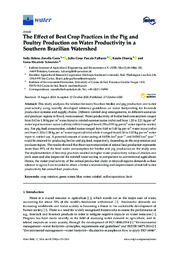The effect of best crop practices in the pig and poultry production on water productivity in a Southern Brazilian Watershed.
The effect of best crop practices in the pig and poultry production on water productivity in a Southern Brazilian Watershed.
Autoria: CARRA, S. H. Z.; PALHARES, J. C. P.; DRASTIG, K.; SCHNEIDER, V. E.
Resumo: This study analyzes the relation between Brazilian broiler and pig production and water productivity using recently developed reference guidelines on water footprinting for livestock production systems and supply chains. Dierent rainfed crop arrangements, in dierent scenarios and producer regions in Brazil, were assessed. Water productivity of broiler feed consumption ranged from 0.63 to 1.38 kg perm3 water input to rainfed summer maize (safra) and from 1.20 to 2.21 kg perm3 water input to winter maize (safrinha) while it ranged from 0.28 to 0.95 kg perm3 water input to rainfed soy. For pig feed consumption, rainfed maize ranged from 0.68 to 1.49 kg per m3 water input (safra) and from 1.30 to 2.38 kg perm3 water input (safrinha) while it ranged from 0.30 to 1.03 kg per m3 water input to rainfed soy. A potential amount of water saving of 0.0336 km3 year-1 and 0.0202 km3 year-1 could be attained for producing broiler and pig feed, respectively, depending on the crop rotation and producer region. The results showed that the evapotranspiration of animal feed production represents more than 99% of the total water consumption for broiler and pig production in the study area. The implementation of best crop practices resulted in higher water productivity values of chicken and pork meat and also improved the rainfall water-saving in comparison to conventional agriculture. Hence, the water productivity of the animal production chain in tropical regions demands a close relation to agriculture in order to attain a better understanding and improvement of rainfall water productivity for animal feed production.
Ano de publicação: 2020
Tipo de publicação: Artigo de periódico
Unidade: Embrapa Pecuária Sudeste
Palavras-chave: Blue water, Crop rotation, Farm, Green water, Rainfed, Soil evaporation
Observações
1 - Por padrão são exibidas publicações dos últimos 20 anos. Para encontrar publicações mais antigas, configure o filtro ano de publicação, colocando o ano a partir do qual você deseja encontrar publicações. O filtro está na coluna da esquerda na busca acima.
2 - Para ler algumas publicações da Embrapa (apenas as que estão em formato ePub), é necessário ter, no celular ou computador, um desses softwares gratuitos. Sistemas Android: Google Play Livros; IOS: iBooks; Windows e Linux: software Calibre.
Acesse outras publicações
Acesse a Base de Dados da Pesquisa Agropecuária (BDPA) para consultar o acervo completo das bibliotecas da Embrapa.

